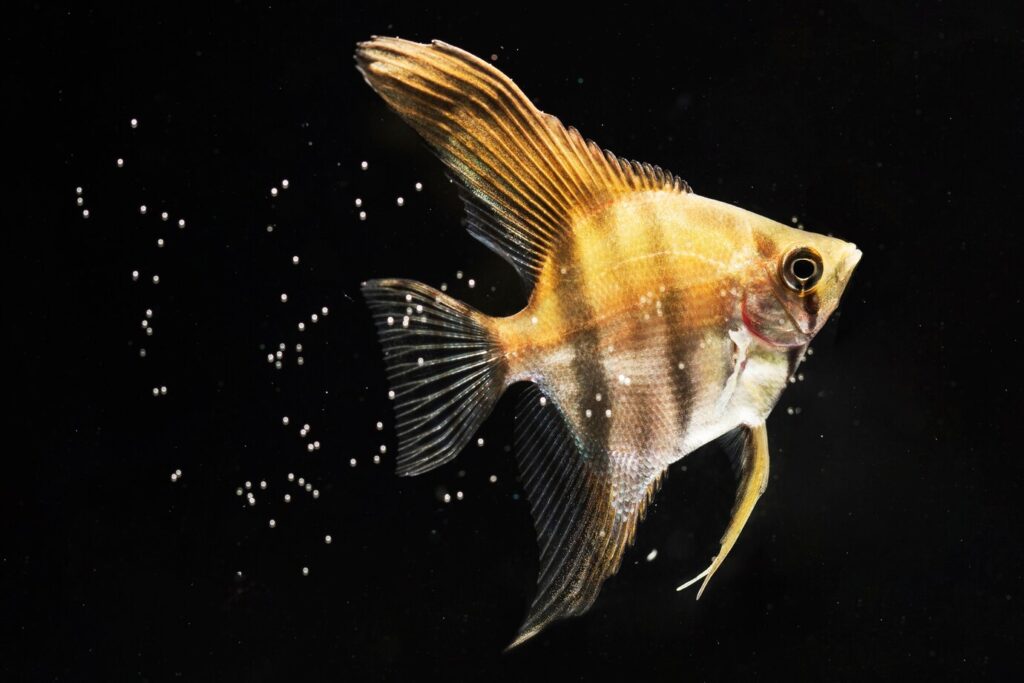Keeping angelfish can be a rewarding experience. These beautiful and graceful fish are a popular choice for both novice and experienced aquarists. In this comprehensive guide, we’ll cover everything you need to know about keeping angelfish happy and healthy in your aquarium. From tank setup to feeding, we’ll ensure you have all the information to create a thriving environment for your angelfish.
Introduction to Angelfish
Angelfish are a type of freshwater cichlid native to the Amazon Basin in South America. Known for their striking appearance and elegant movements, they come in various colors and patterns. Angelfish can grow up to 6 inches in length and require a well-maintained environment to thrive.
Choosing the Right Tank
Tank Size
Angelfish need ample space to swim and grow. A minimum of a 20-gallon tank is recommended for a pair, but a 30-gallon or larger tank is ideal if you plan to keep more.
Tank Shape
A tall tank is preferable due to the angelfish’s body shape. They have long, flowing fins that require vertical swimming space.
Setting Up the Aquarium
Substrate Selection
Use a fine substrate like sand or smooth gravel to mimic their natural habitat. Avoid sharp-edged substrates that could damage their delicate fins.
Plants and Decorations
Angelfish appreciate a planted tank with plenty of hiding spots. Use a mix of live plants such as Amazon swords, Java fern, and Vallisneria. Include driftwood and rocks for additional shelter.
Filtration System
A reliable filtration system is crucial. Choose a filter that provides gentle water flow, as angelfish prefer calm waters. Canister filters or sponge filters work well.
Water Parameters
Temperature
Maintain a stable water temperature between 75-82°F (24-28°C). Use a heater and thermometer to monitor and adjust the temperature as needed.
pH Levels
Angelfish prefer slightly acidic to neutral water. Aim for a pH between 6.5 and 7.5.
Hardness
Keep the water hardness between 3-8 dGH. Soft to moderately hard water is ideal.
Introducing Angelfish to the Tank
Acclimation Process
When introducing new angelfish to your tank, use the drip acclimation method. This gradual process helps them adjust to the new water conditions and reduces stress.
Feeding Your Angelfish
Types of Food
Angelfish are omnivores and thrive on a varied diet. Offer high-quality flake food, pellets, frozen foods (such as brine shrimp and bloodworms), and fresh vegetables.
Feeding Schedule
Feed your angelfish 2-3 times a day. Offer only what they can consume within 2-3 minutes to prevent overfeeding and water pollution.
Tank Mates for Angelfish
Compatible Fish
Choose peaceful tank mates that won’t nip at the angelfish’s fins. Good options include tetras, gouramis, and Corydoras catfish.
Fish to Avoid
Avoid Fish keeping aggressive or fin-nipping species like barbs and some cichlids. These can stress or harm your angelfish.
Breeding Angelfish
Identifying Pairs
Mature angelfish form monogamous pairs. Look for a pair that stays close together and defends a territory.
Breeding Setup
Set up a separate breeding tank with a flat surface for egg-laying, such as a piece of slate or a broad leaf. Maintain optimal water conditions to encourage spawning.
Caring for Fry
After the eggs hatch, remove the parents to prevent them from eating the fry. Feed the fry with infusoria or liquid fry food initially, then gradually introduce baby brine shrimp.
Common Health Issues and Treatments
Recognizing Symptoms
Watch for signs of illness, such as clamped fins, white spots, or erratic swimming. Early detection is crucial for effective treatment.
Treatment Options
Quarantine sick fish keeping and treat with appropriate medications. Maintain excellent water quality to prevent disease outbreaks.
Maintaining the Aquarium
Regular Cleaning
Perform weekly water changes of 25-30% to maintain water quality. Clean the substrate and decorations to remove debris.
Water Changes
Use a gravel vacuum during water changes to remove uneaten food and waste from the substrate.
Behavioral Observations
Social Interactions
Angelfish are generally peaceful but can exhibit territorial behavior, especially during breeding. Observe their interactions to ensure harmony in the tank.
Stress Signs
Signs of stress include loss of color, rapid breathing, and hiding. Address the cause promptly, such as poor water quality or aggressive tank mates.
Tips for a Thriving Angelfish Aquarium
Patience and Observation
Patience is key when keeping angelfish. Observe their behavior and environment regularly to catch any issues early.
Continuous Learning
Stay informed about the latest fish keeping techniques and angelfish care tips. Join online forums and communities for advice and support.
Conclusion
Keeping angelfish can be a fulfilling hobby. By providing a well-maintained tank, balanced diet, and suitable tank mates, you can enjoy the beauty and tranquility of these stunning fish. Remember, the key to successful fish keeping is continuous learning and attention to detail. With proper care, your angelfish will thrive and bring joy to your aquarium. If you want to learn more like this the click infiniteinsighthub
FAQs
- What is the ideal tank size for angelfish?
- A minimum of 20 gallons for a pair, but 30 gallons or larger is recommended for more.
- What do angelfish eat?
- Angelfish are omnivores. They eat high-quality flake food, pellets, frozen foods, and fresh vegetables.
- How often should I clean my angelfish tank?
- Perform weekly water changes of 25-30% and clean the substrate and decorations regularly.
- Can angelfish live with other fish?
- Yes, angelfish can live with peaceful tank mates like tetras, gouramis, and Corydoras catfish.
- How can I tell if my angelfish are stressed?
- Signs of stress include loss of color, rapid breathing, and hiding. Address the cause promptly.
Stay tuned for more news and updates on Infinite Insight Hub!



